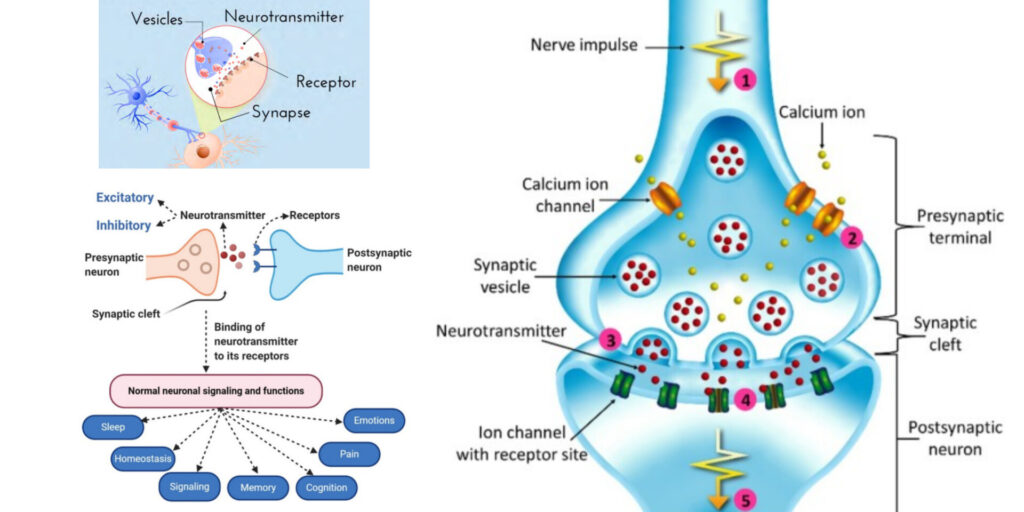Unit-4: Neurotransmitters & Their Mode of Action What are Neurotransmitters?
Neurotransmitters are chemical messengers that transmit signals from a neuron to a target cell (another neuron, muscle cell, or gland cell) across a synapse .
They are essential for rapid communication between neurons.
Stored in synaptic vesicles on the presynaptic side of a synapse and released into the synaptic cleft .
Structure of a Chemical Synapse: [Presynaptic Neuron]
↓
Synaptic Vesicles (with neurotransmitters)
↓
Synaptic Cleft
↓
Receptors on Postsynaptic Neuron
↓
[Biological Response]
Properties of Neurotransmitters:
Synthesized in the presynaptic neuron.Stored in vesicles inside the presynaptic neuron.Released under specific physiological conditions.Removed quickly from the synaptic cleft via reuptake or enzymatic degradation .The postsynaptic neuron has specific receptors for neurotransmitters.
Binding of neurotransmitter to receptor causes a biological response .
Types of Neurotransmitters: Type Examples Excitatory Acetylcholine, Glutamate, Aspartate Inhibitory GABA (Gamma-Aminobutyric Acid), Glycine Mixed Dopamine, Serotonin, Nor-epinephrine
GABA (Gamma-Aminobutyric Acid) Introduction:
GABA is the major inhibitory neurotransmitter in the central nervous system (CNS).It slows down nerve activity , promoting calmness.
Chemical formula: C₄H₉NO₂
GABA is a zwitterion (has both positive and negative charges).
Discovery:
In the 19th century , known as a metabolite in plants and microbes.
In the 20th century , isolated as an amino acid in mouse brains.
In 1950 , Roberts and Frankel discovered GABA acts as an inhibitory neurotransmitter in the human brain.
Synthesis of GABA:
Precursor : L-Glutamic AcidEnzyme : Glutamate Decarboxylase (GAD)Reaction :GAD removes a carboxyl group from glutamate to produce GABA.
Found in neurons, pancreas, and other body fluids.
GABA Receptors:
GABA-A Receptor :
Pentameric structure.
Functions as a ligand-gated ion channel .
Subunits: 2 alpha + 2 beta + 1 gamma.
Causes chloride ion (Cl⁻) influx , leading to inhibition .
GABA-B Receptor :
G-protein coupled receptor (heterodimer).Subunits: B1 (binds GABA) and B2 (activates G-protein).
Effects: ↓ Calcium ion (Ca²⁺) conductance, ↑ Potassium ion (K⁺) conductance → hyperpolarization.
Functions of GABA:
Reduces anxiety .
Helps in pain relief .
Regulates sex hormones .
Used in treatment of ADHD (Attention Deficit Hyperactivity Disorder).
Promotes fat burning .
Helps stabilize blood pressure .
Can lower blood sugar in diabetics.
Glutamate (Glutamic Acid) Introduction:
A non-essential amino acid .
Major excitatory neurotransmitter in the CNS.
Known as the “King of Neurotransmitters” and “Master Switch of the Brain” .
Has the highest concentration among all amino acids and neurotransmitters in the brain.
Functions of Glutamate:
Crucial for learning and memory .
Supports neuroplasticity .
Excess glutamate can be toxic (excitotoxicity).
Synthesis of Glutamate:
Precursor : Alpha-Ketoglutarate (from the TCA cycle).Reaction :Glutamate does not cross the blood-brain barrier , so it must be synthesized in the brain .
Regulation of Glutamate:
20% of turnover via glutamate transporters .40% through the glutamine cycle .Reuptaken into vesicles for storage or broken down as needed.
Quick Recap (Exam Ready Points):
GABA : Inhibitory; made from glutamate using GAD enzyme.GABA-A : Ion channel receptor; fast response .GABA-B : G-protein receptor; slow, prolonged response .Glutamate : Most abundant excitatory neurotransmitter.Glutamate can’t cross the BBB → must be synthesized in CNS .
Both GABA and Glutamate are crucial for neurobalance .
Posts navigation
Kritika Group Of College, Bareilly

